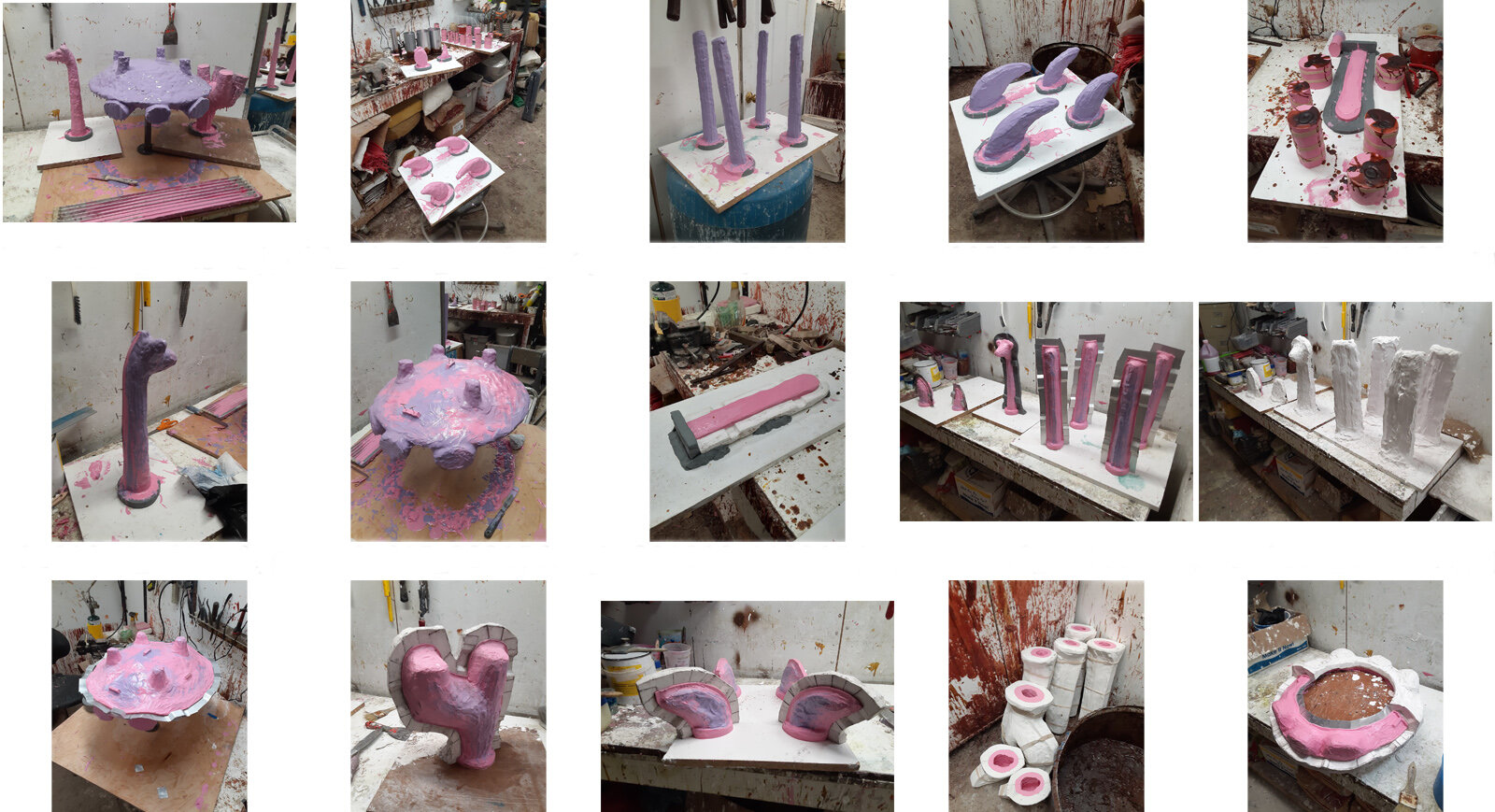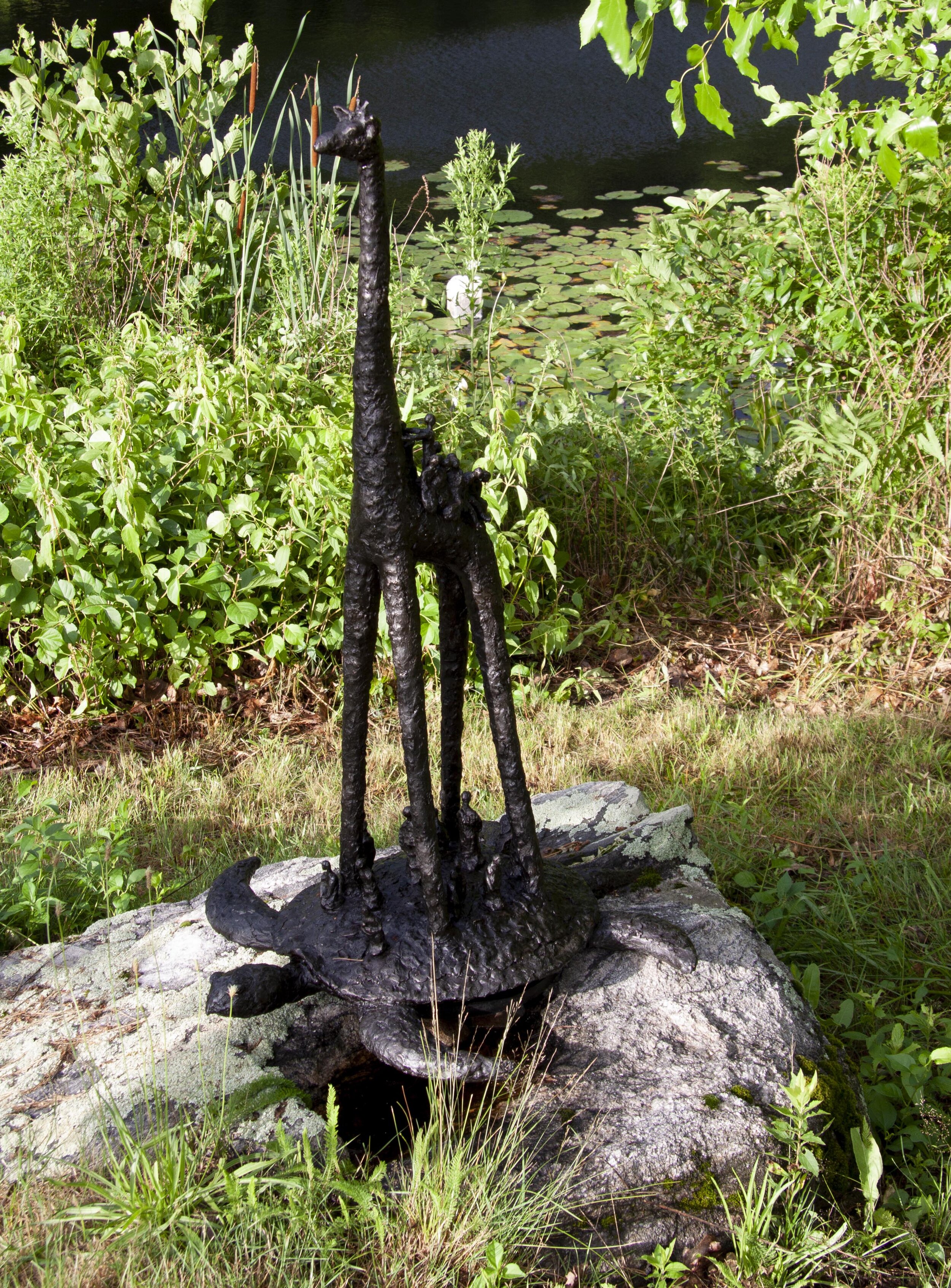It’s crazy how a nose from one direction can look perfectly fine, and viewed from 180 degrees, it’s too close to the eye. When I work on small wax figures, I turn them continuously around in my hands, making sure, for example, the left elbow doesn’t extend below the hip while I carve the right side of the torso. Working on a larger piece, I circle continuously; this partner dance assures everything works from all perspectives.
Refuge, 2020, in wax in my studio. The endangered sea turtle and giraffe are rescuing the humans.
Our planet faces a ferocious loss of habitat, fifty percent of the species on the earth have disappeared in the last forty to fifty years. We’re a destructive species causing the acidifying of the ocean, the loss of precious topsoil, and the poisoning of the very air we breathe. The animals haven’t caused this harm—we have. But I like to think, despite our recklessness and selfishness, they would choose to save us.
I delivered Refuge to the foundry in early January, needing to cut off the giraffe’s legs to fit in my car.
The turtle arrives at the foundry.
Not a problem for Zach Gabbard, owner and sole fabricator at Mission Foundry in Hyde Park. He will be taking it further apart—flippers, turtle shell, giraffe head, giraffe tail, turtle tail, and each individual person to make rubber molds.
Once he has the rubber molds, he will pour casting wax into them—the small figures solid, the large shapes like the giraffe body receive a thin layer so they can be hollow. When Zach has these wax pieces complete, he will attach the small ones together and build a funnel above each one—the constructions, intriguing modern mobiles.
The next step is to create the molds to receive the molten bronze. Each of these wax mobiles are dipped into a silica slurry nine times to slowly building up the mold. They are dipped, then coated with sand, and hung to dry for at least a day between dips.
At the pour, the funnel on top of each mold receives the liquid bronze, the wax melts out, lost wax, and the bronze hardens. These hard shells are then hammered and broken to free them from the bronze inside.
There are still days of work ahead for Zach. He has to cut off the sprues and funnels. He has to sandblast each piece to get the specks of hard shell out of every crevice. Then the individual pieces will be welded together. Zach has to know how to replicate the textures I sculpt in my wax sculpture, and he has to do it in metal so the welded seams disappear. He has to care about the subtleties of the texture, with the deliberateness of a poet choosing words to describe the grooved furrows of an oak trunk.
I returned to the foundry a few weeks ago to position each of the the small bronze figures on the backs of the giraffe and turtle. Zach welded each one in place.
Then Refuge received its final patina and wax polish. It’s a long process. This piece is signed and numbered 1/5. Though my original waxes have disappeared, I have the molds to make four more copies. But always, for each one, we have to first make a new wax model, then cast it into bronze. After five copies, we’ll destroy the molds.
Lost wax is an apt metaphor for these times: The only way to create something new is to lose something. While we are collectively facing tremendous loss, it is good to reflect on the space that allows for something new to arise. The loss is real—people’s lives, habitat, species, jobs, freedom. I am alarmed, but I dearly want to believe that we can turn things around. We need humility. We need respect for every living being on the planet. Then the turtle and the giraffe, the heron and the wasp, the oak, the waterlily, and even the gnat will all be helping because we are all interconnected.
Refuge would have been outdoors at the Fuller Museum this summer, but Covid has delayed the opening of the New England Sculptors Exhibit until spring 2021. It sits on a chunk of bedrock outside my studio. I’d love to send more casting work Zach’s way, so if you would be interested in a copy of Refuge for your own garden, let’s talk.
Refuge, bronze, 2020
Refuge is a hopeful piece. The determined, young giraffe and the tireless turtle are unconcerned with the enormity of their mission. They echo the world’s need for us to engage, to bring our gifts, and to offer help in this time of great loss. It’s a collective dance we can’t do alone.















